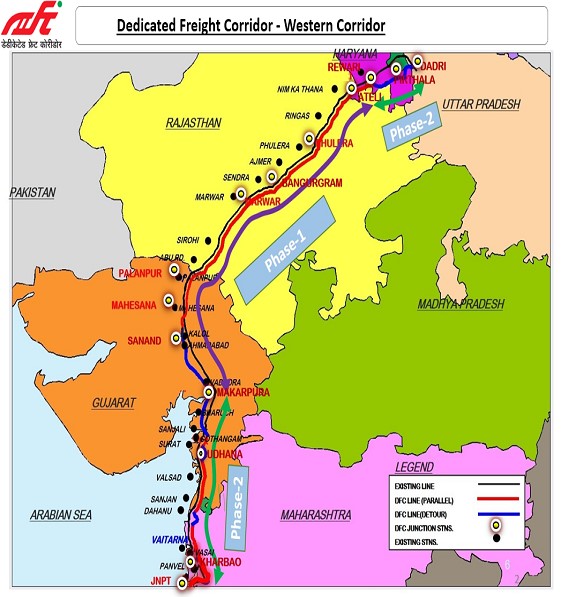Table of Contents
Eastern Dedicated Freight Corridor (EDFC)
The Eastern Dedicated Freight Corridor (EDFC) is poised to revolutionize freight transportation across the nation, marking a significant milestone with the successful trial on the New Pilkhani-New Shambhu section of the corridor, as announced by the Ministry of Railways. The initiation of commercial freight train operations on the Pilkhani-Sahnewal section further underscores the corridor’s readiness for transformative impact.
The Ministry took to social media platform X to share the news, expressing enthusiasm about the successful trial. A 20-second video clip showcasing the freight train traversing the Eastern Dedicated Freight Corridor was also shared by the ministry, gaining considerable traction with 37,000 views at the time of reporting.
PM Modi on Eastern Dedicated Freight Corridor (EDFC) in Vibrant Gujarat
Notably, Prime Minister Narendra Modi highlighted the significance of the EDFC during the Vibrant Gujarat Global Summit (2024). He emphasized the connection of regions like Gujarat, Maharashtra, and the Eastern Coast Line through dedicated freight corridors, reinforcing the commitment to fostering economic growth and connectivity.
“Be it Gujarat, Maharashtra, or our Eastern Coast Line, today they are being connected through dedicated freight corridors,” PM Modi had said.
You can also read: L&T Secures Mega Order For Mumbai-Ahmedabad Bullet Train Electrification Project!
The Purpose Of Dedicated Freight Corridors (DFCS)
Dedicated Freight Corridors (DFCs) address critical challenges in the existing railway infrastructure. The Golden quadrilateral, connecting major cities like Delhi, Mumbai, Chennai, and Howrah, along with its diagonals, has been operating at high capacity utilization, leading to congestion and delays. These corridors, constituting only 16% of the railway route, carry over 52% of passenger traffic and 58% of revenue-earning freight traffic.
Over the years, the share of Indian Railways in freight traffic dwindled from 88% in 1950-51 to 26% in 2021-22. To counter this trend, DFCs have been conceptualized to enhance capacity, reduce logistics costs, and improve the safety and speed of freight movement.
Dedicated Freight Corridors (DFCS)
Eastern Dedicated Freight Corridor Project
- Stretch: Ludhiana in Punjab to Sonnagar in Bihar (1337 km).
- Construction Timeline: Commenced in 2014 and completed in 2023.
- Composition: Two segments – an electrified double-track segment of 1409 km from Dankuni (West Bengal) to Khurja (Uttar Pradesh) and an electrified single-track segment of 447 km from Ludhiana (Dhandarikalan) to Khurja to Dadri in Punjab, Haryana, and Uttar Pradesh.
- Stations: EDFC features 21 stations along its route.
- Eastern Dedicated Freight Corridor Fully Completed in 2023
Eastern Dedicated Freight Corridor Map

Eastern Dedicated Freight Corridor Status
Eastern Dedicated Freight Corridor Fully Completed in 2023. The construction of the Eastern Dedicated Freight Corridor is over.
You can also read: FILMFARE AWARDS 2024 NOMINATIONS: UNVEILING THE GLITTERING CONTEST!
Western Dedicated Freight Corridor Project
- Stretch: Dadri in Uttar Pradesh to Jawaharlal Nehru Port Trust (JNPT) in Mumbai (1506 km).
- Completion Status: 78% completion.
- Stations: WDFC incorporates 25 stations along its route.
Western Dedicated Freight Corridor Map

Western Dedicated Freight Corridor Status
Work is ongoing on the Western Dedicated Freight Corridor, with 1176 km out of the total 1506 km already accomplished. These corridors are integral to the government’s vision for a more efficient and streamlined freight transportation network, contributing to the country’s economic development.
Gati Shakti Cargo Terminals (GCTS)
In addition to DFCs, the Ministry of Railways has introduced Gati Shakti Cargo Terminals (GCTs). These terminals are multimodal logistics facilities that efficiently handle rail cargo alongside other modes of transportation such as road or water transport. Unlike traditional approaches, GCTs are being developed by private entities with minimal government intervention.
To date, 15 GCTs have been commissioned, and approximately 96 locations have been provisionally identified for GCT development. The ambitious plan aims to commission 100 GCTs within the next three financial years (2022-23).
You can also read: NAVIGATING THE CHANGES: UNDERSTANDING NEW CREDIT CARD RULES IN 2024 FOR HDFC, SBI CARD, ICICI, AND AXIS BANK!
Advantages of Dedicated Freight Corridors (DFCs) and Goods Corridor Terminals (GCTs)
- Fueling Economic Growth and Development: Dedicated Freight Corridors (DFCs) and Goods Corridor Terminals (GCTs) play a pivotal role in India’s ambitious vision of becoming a global leader in the logistics sector. These infrastructural initiatives expedite the movement of goods from major ports and industrial hubs to hinterland areas, thereby catalyzing economic growth.
- Expanding Employment Opportunities: The implementation of DFCs and GCTs creates a ripple effect of employment opportunities across diverse sectors, including manufacturing, agriculture, and mining. This not only enhances job creation but also contributes to the overall socio-economic development of the region.
- Attracting Investments: The streamlined logistics and transportation facilitated by DFCs and GCTs make them attractive hubs for investments. This, in turn, contributes significantly to the development of India’s infrastructure, fostering a conducive environment for economic growth and progress.
- Seamless Integration of Transportation Modes: Goods Corridor Terminals (GCTs) serve as pivotal points for the seamless integration of rail transport with other modes, enabling customers to select transportation methods based on factors such as cost-effectiveness and convenience. This integration enhances the overall efficiency of the transportation network.
- Alleviating Congestion: Goods Corridor Terminals (GCTs) play a crucial role in alleviating congestion at railway stations. This not only improves the efficiency of freight transportation but also enhances passenger amenities, contributing to a smoother and more streamlined transportation network.
You can also read: RPF Recruitment 2024: Notification Out For 2250 Constable And SI Posts; Read In Detail..


I want to thank you for your assistance and this post. It’s been great.